
Types of Cut Resistant Gloves
Do your business's cut resistant gloves make the cut? Hand cuts and wounds are preventable accidents in the workplace, yet they account for a hefty percentage of injuries and lost employee time in the United States. Protecting employees' hands in the foodservice industry should be a high priority, but choosing the right cut resistant glove for your work environment isn't the easiest task.
Slices, cuts, abrasions and punctures are all common workplace injuries, especially in the foodservice industry. But did you know these types of accidents account for almost 30% of lost time and productivity, and almost 80% of these injuries involve workers' hands? It's important to protect yourself and your employees with cut resistant gloves in order to maintain a company that's efficient with high productivity levels in order to maintain growth. But where does the process of choosing an effective cut resistant glove begin?
Shop All Cut Resistant Gloves
What I Need to Know Before Buying Cut Resistant Gloves
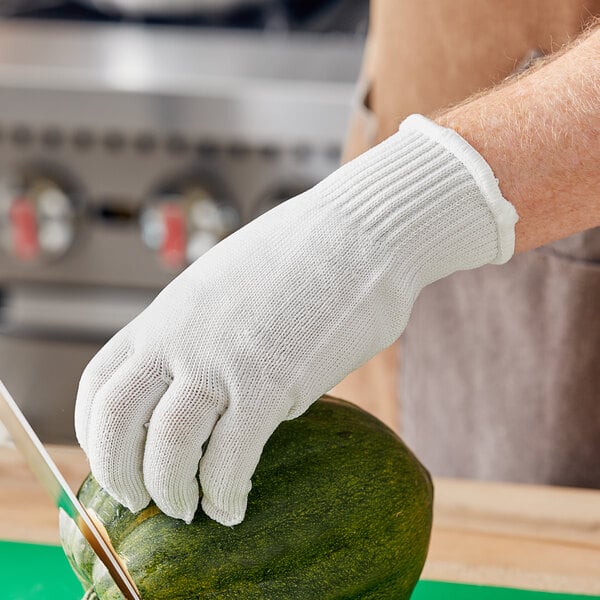
When thinking about the process of choosing a cut resistant glove for your business, it's pertinent to first understand the concept of cut resistance. Cut resistance is a function of a glove's material makeup and its thickness. Therefore, the heavier weight a glove's material is (oz. / square yard), the greater the protection.
If this is true, then it should be simple to protect your employees-go with the heaviest material glove the market has to offer, right? The major issue with cut resistant gloves revolves around your employees. Do your gloves offer comfort and mobility? If not, more times than not, your employees won't even wear them, despite the safety hazards. The major goal is to protect workers without causing an obtuse level of discomfort and mobility restriction. To tackle this, you need to understand the various cut resistant materials that exist.
Levels of Cut Resistant Gloves
There are a variety of fibers and fabrics used and intertwined to meet the requirements of different levels of cut resistant gloves. Every working environment has different protection needs, influencing your decision on the best glove for your business. Restaurants may need lower levels as they're slicing and dicing vegetables, while butchers may need higher levels as they're sawing through thick meats. The glove you choose for your business is the single barrier preventing the possibility of serious injury.
The cut resistance of a material is determined by four factors: strength, hardness, lubricity, and rolling action. A yarn that possesses more of these four characteristics will typically have a higher cut resistance than a glove that utilizes only one factor. To test a glove's cut resistant level, manufacturers usually abide by the standards of a testing agency known as American National Standards Institute (ANSI). ANSI provides a material's cut resistance in grams of weight applied to the tested material. An ANSI level is determined by how much weight is needed to cut through a given material with 25 mm of blade travel. In 2016, ANSI updated the way they label cut resistance levels in order to encompass gloves with very high levels of cut resistance. As it takes time and retesting to get gloves from 2015 and earlier up to date with the new standard, the old levels are still commonly seen. New levels range from A1 to A9, while old levels range from 0 to 5, with either A9 or 5 providing the highest level of cut resistance. Below you will find a table of ANSI levels to assist you while shopping for the best cut resistant glove.
ANSI Cut Resistant Level: Grams Of Weight Needed To Cut Through Material
- A1: Greater than 200
- A2: Greater than 500
- A3: Greater than 1000
- A4: Greater than 1500
- A5: Greater than 2200
- A6: Greater than 3000
- A7: Greater than 4000
- A8: Greater than 5000
- A9: Greater than 6000
Old Standards for Cut Resistant Gloves
- 1: Greater than 200
- 2: Greater than 500
- 3: Greater than 1000
- 4: Greater than 1500
- 5: Greater than 3500
Common Cut Resistant Gloves Materials
As the above table shows, the higher level a material is rated, the more cut resistant it is. We offer a variety of cut resistant gloves made from different cut resistant materials, all meeting ANSI standards and falling under ANSI levels. Whether you're looking for gloves offering basic protection for light kitchen prep or you're looking for maximum strength gloves for handling meat and poultry, you have a world of options! We offer various cut resistant materials, available in a range of colors and sizes.
Kevlar Fiber
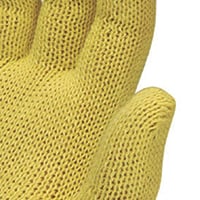
- The Kevlar fiber is a para-aramid synthetic fiber that offers high cut resistance. Most of our gloves made from synthetic fibers fall under ANSI level A2.
- 5x stronger than steel per unit weight
- Inherent flame resistance makes these Kevlar kitchen gloves ideal for high heat kitchen environments
- Relatively lightweight construction provides comfort in addition to increased protection
- Ideal for food preparation and other applications such as glass handling and automotive applications
Spectra Fiber
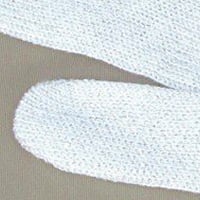
- The Spectra fiber is an ultra-high molecular-weight polyethylene fiber that offers cut resistance even when wet. Most of our gloves made from Spectra fibers fall under ANSI level A4 or A5.
- 15x stronger than steel per unit weight
- 40% stronger than aramid fibers
- Extremely durable
- Offer comfort and flexibility
- Low-density allows gloves to float on water, making them moisture resistant
- UV light and chemical resistant
- Lightweight construction makes gloves comfortable, increasing user's compliance to wear
- Ideal for food processing and for restaurant and foodservice applications
Dyneema Fiber

- The Dyneema fiber is a gel-spun, multi-filament fiber created from ultra-high molecular weight polyethylene, renowned as "The World's Strongest FibreTM." Dyneema offers extremely high cut resistance and most of our gloves made from Dyneema fibers fall under ANSI level A4, and our other Dyneema gloves are blended with spiral wrapped steel, increasing their cut resistance to level A5.
- 15x stronger than steel per unit weight
- 40% stronger than aramid fibers
- Extremely durable
- Offer comfort and flexibility
- Low-density allows gloves to float on water, making them moisture resistant
- UV light and chemical resistant
- Handle extreme hot and cold temperatures
- Ideal for all food preparation ranging from slicing, dicing and chopping fruits and vegetables to cheeses and meats
Metal Mesh

- Metal mesh is composed of interlocked stainless steel mesh and provides advanced cut and puncture resistance. Most of our gloves made from metal mesh fall under ANSI level A5, providing maximum protection.
Note that gloves composed of 100% metal mesh are the only type of cut resistant glove that provide puncture resistance. Other gloves protect hands from slices, not punctures.- Widely used in industries utilizing extremely sharp cutting tools and instruments
- Feature convenient ambidextrous design
- Offer high hygiene
- Lead to increased durability due to 100% stainless steel construction and lack of fabric straps
- Ideal for meat and poultry applications; Excellent for use as butcher gloves
Choosing the Best Cut Resistant Gloves
It all begins with research!
- Evaluate your environment.
- Are injuries occurring frequently?
- Where / when do these injuries occur? At prep stations? During kitchen rush hours?
- How do they occur? With basic cutlery? Larger knives? Machines?
- What's the cut resistance level of you current gloves, and are they actually being worn? If not, is it due to discomfort or lack of flexibility and mobility?
- Identify solutions.
- Will a more comfortable glove encourage my employees to actually wear provided gloves?
- Do I need a higher level of cut resistance due to the kitchen tasks we are performing?
- Do I need a glove that offers heat resistance or moisture resistance in addition to cut resistance?
Depending on your needs, the best choice is to determine a glove you believe will best suit your business's environment and test it out! With our extensive range of cut resistant gloves available in different sizes, colors and styles, you'll be sure to find the glove that will make the cut!
Related Resources
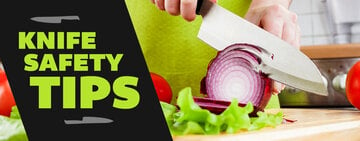
Knife Safety Tips
Knife safety is of utmost importance in any commercial kitchen. Improper handling and usage of knives can lead to serious accidents and injuries. We will explore essential knife safety tips that every professional chef and kitchen staff should be aware of. By following these guidelines, you can enforce restaurant safety protocols in your kitchen while minimizing the risk of accidents. Use these links to learn more about knife safety: Use a Sharp Knife Choose the Right Knife for the Task Know the Proper Knife Cutting Techniques Use Caution When Handling a Knife Keep Your Knives Clean Store Your Knives Correctly Kitchen Knife Safety From " avocado hands " to cuts while washing knives, lacerations from chef knives are one of the most common in
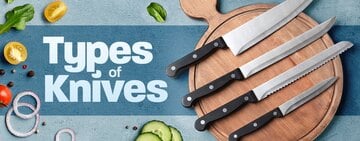
Types of Knives
Knives are the most important tool in a chef's kit, and they can be used for just about any food prep task from chopping onions and butchering a cut of beef to opening oysters and slicing bread. But, there are different types of kitchen knives that are designed for various purposes. This comprehensive guide covers the types of knives and their uses, so you can find the right option for your needs. Shop All Kitchen Knives Use the following links to navigate and learn about the different types of knives: Kitchen Knife Types Types of Table Knives Parts of a Knife Carbon Steel vs Stainless Steel Knives Forged vs Stamped Knives Types of Knife Edges Knife Handle Styles Knife Maintenance Kitchen Knife Storage
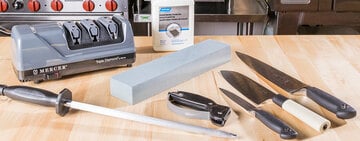
Knife Sharpeners Buying Guide
No matter what type of knife you own, it's essential to keep it sharp for the best results. Sharp knives make food prep easier and require less pressure to achieve your desired cuts, contributing to a safe kitchen environment . If you aren't familiar with knife sharpeners, it can be difficult to determine the sharpener that best fits your needs. In this guide, we'll introduce the different types of sharpeners, bevels, and knife angles so that you can make an informed decision. Shop All Knife Sharpeners Use the following links to learn more about the types of knife sharpeners: Electric Knife Sharpeners Sharpening Stones Sharpening Steels Serrated Knife Sharpeners Handheld Knife Sharpeners
- Topics 1346
- Industrial 55
- Troubleshooting Guides 21
- Restaurant Management 128
- Bar Management 55
- Catering Tips 35
- Bakery Management 42
- Food Trucks & Concessions 49
- Advertising & Marketing 37
- Eco-Friendly Tips 11
- Facility Layout & Design 41
- Coffee Shop Tips 28
- Installation & Maintenance 51
- Janitorial & Pest Control 30
- Safety & Sanitation 88
- Startup Tips 104
- Menu Design 10
- Kitchen & Cooking Tips 81
- Hospitality Management 23
- Pizza & Sandwich Shop Tips 36
- Smallwares 37
- Food Prep 88
- Tabletop Items 17
- Disposables 22
- Calculators & Tools 6
- Consumables 52
- Warewashing & Laundry 18
- Cooking Equipment 90
- Food Storage & Refrigeration 51
- Beverage Equipment 34
- Office Supplies 6
- Resource Type
- In-Depth Articles272
- Buying Guides296
- How-Tos93
- Product Reviews77


